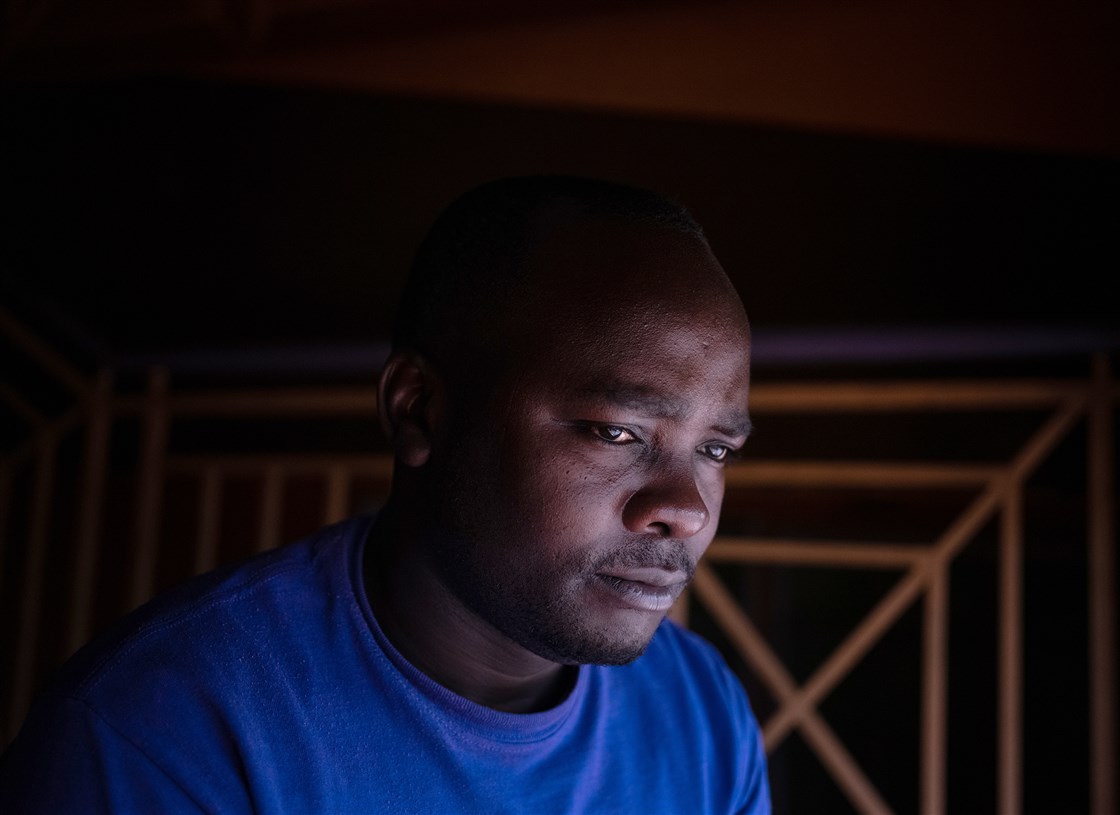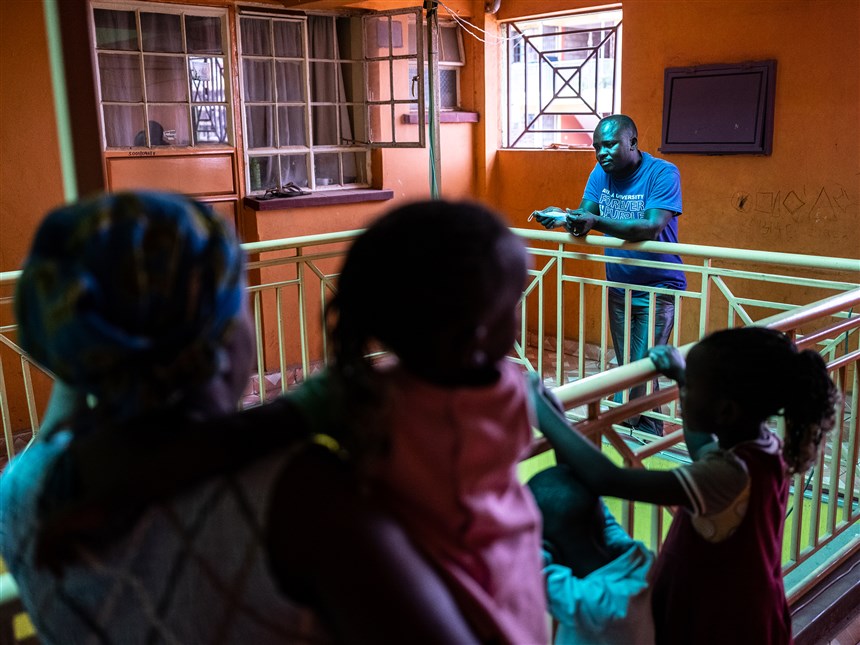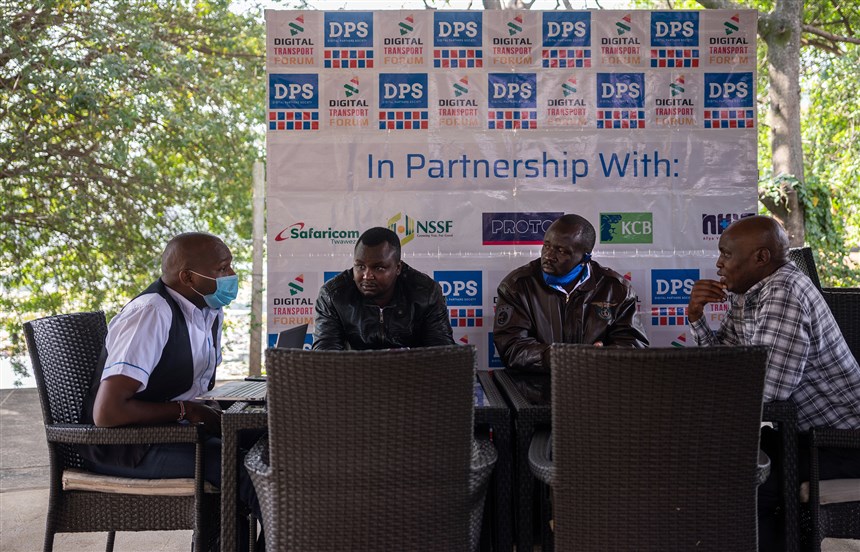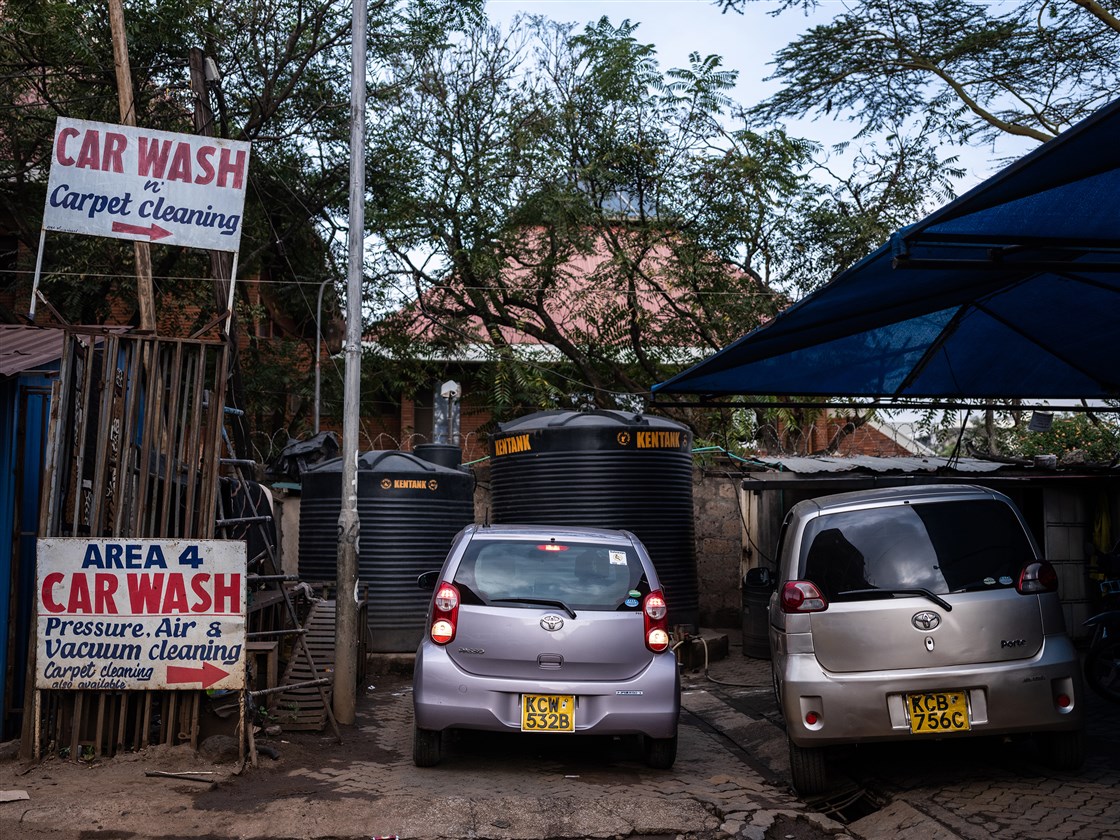At first, work as an Uber driver seemed to offer Harrison Munala everything he’d hoped for when he moved from a town in the western part of Kenya to its capital, Nairobi.
After nearly 15 years of informal employment as a house cleaner and school bus driver, Uber seemed like the answer — not only to Munala, but also to many of the energetic hustlers with middle class aspirations who flock to East Africa’s economic hub.
Work with Uber was so good that about three years ago, after a year driving a car he rented privately for 15,000 shillings a week (at the time, about $150), Munala borrowed money from his sister for the down payment on a Toyota Passo, a compact car. And he took out a loan from Izwe, a Pan-African microfinance and loan company.
Now, Munala figured, he could work for Uber and pay off the car. Then he could expand his business, buy another car, and hire someone else to drive.
“I felt like I made it in life,” he recalled.

Four years after Uber entered his life, Munala, now 34, grimaces in remembering those dreams.
Uber slashed its fares — and Munala’s income. It introduced new categories of cars, allowing smaller cars. And because they were cheaper and more fuel-efficient, passengers flocked toward the smaller cars.
That adversely affected the drivers who were already saddled with the larger, four-door cars with more powerful engines that Uber had previously required.
More and more drivers flooded the platform, changing the basic earning premise that had prompted people like Munala to take out loans to become drivers.
And car maintenance grew costly. Fuel prices ran high. Instead of owning an asset, Munala’s debts swelled.
Uber’s hard sell
Uber came to Kenya, a country of densely populated cities without efficient public transport, and aggressively signed up drivers while increasing ridership by dropping prices.
Interviews with more than 80 current and former taxi drivers in Nairobi and the port city of Mombasa show that, in Kenya’s biggest markets, untold numbers of Uber drivers are drowning in debt.
To qualify for the Uber sticker, they borrowed heavily to lease cars, sometimes via programs facilitated and promoted by Uber, sometimes through other companies. Uber employs more than 12,000 drivers in Kenya. All of the 80-plus interviewed expressed distress and said they were barely making ends meet. Far from Kenya, a labor economist at Stanford University’s Graduate School of Business who drove for Uber for research has similar findings.
Paul Oyer said that, at least in the United States, drivers who work on the platform might be satisfied with the business if they already owned their car or have other sources of income.
But, he said, “It doesn’t make a lot of sense to go out and invest a lot of money in a car for the sake of driving it for Uber; there isn’t enough money to be made for your time and the costs of car ownership.”
The vast majority of the Uber drivers interviewed by 100Reporters in Kenya said they do not own their cars and instead drive a “partner’s” car — renting it from a private citizen.
Lorraine Onduru, a spokesperson for Uber, said it was offering “vehicle solutions products” to drivers already on the platform.
“Agreements with third-parties are discussed and agreed between the driver and the financial institution,” she said.
According to Onduru, there are channels through which drivers can transmit questions to Uber, and the banks with which Ubers programs are affiliated offer financial literacy workshops.
Well before the coronavirus worsened the situation, some drivers were living out of their vehicles. Other drivers said they had sold their TVs and other electronics to keep their cars from being repossessed — sometimes without success.
Many said they did not understand the contracts they’d signed with Uber or with lenders. But Uber says that, at the onboarding process, it hosts training sessions to ensure drivers do comprehend the terms and conditions.
To be sure, there are Uber drivers in Kenya who do pay off their loans. Some tie their success to strategic timing or to other sources of income. But many who have managed to pay off their cars still express dissatisfaction with Uber; even now that they own their cars outright, they say, they are not making money.
Peter Mwinga, who quit driving for Uber last year, said he earns more selling fruit and vegetables out of the back of his Toyota Fielder, which he still hasn’t paid off after three years as a driver. Standing next to the vehicle filled with produce and parked at the side of the road and filled with produce, Mwinga said he “wouldn’t advise” someone to join Uber.
A toxic relationship
When Uber started operating in Kenya in June 2015, it built on the rump of an empire whose structure had changed little despite independence. Kenya was the former British base in Africa, and the colonial economy, based on extraction, relied on masses of workers who profited little.
Today these laborers, classified as “informally employed,” account for 80 percent of Kenya’s population, according to a 2016 World Bank report. Many work in construction, clean houses or sell second-hand clothes, moving from sector to sector, rarely making ends meet. Young women walk through rich neighborhoods, offering to work as maids.
For a lot of laborers in Kenya, the shift from colonial times to the modern era has changed little — other than the color of the leader’s skin.
Initially, Kenyans embraced Uber’s arrival. People needed jobs and the taxi industry was privatized. Before Uber, a taxi rider could be charged almost as much in Nairobi as in New York. Most people got around on crowded “matatus” — unreliable buses that charged less than 50 shillings, or about 50 cents, a ride.
Uber became a welcome addition: drivers got more customers, prices were controlled by the app — a bit lower than if you called a private car — and riders could get an Uber quickly.
At the outset, Uber drivers were making 60 shillings per kilometer — about 97 cents a mile. The company took a 25 percent commission and established requirements for cars it would sign up: They had to be relatively new, about sedan size, and have a large engine, four doors and four seats.
The government paid little attention to the new company’s entry.
Private taxis, however, balked, saying Uber was hurting their business. In a few instances in 2015 and 2016, Ubers were burned and drivers harassed. Over time, though, as customers became accustomed to the convenience and lower prices, drivers lost their regular clients and had to move onto the app to stay in business.
Uber grew its ranks by approaching taxis at airports and mall parking lots.
“It didn’t have to be a hard sell to drivers, once the client numbers started going up,” Julie Zollmann, a doctoral candidate at Tufts University who has been studying finance, technology and livelihoods in Kenya since 2010, wrote in an email.
“It solved a big problem for independent drivers who were only otherwise getting a few trips per day and, at that time, the rates were significantly higher than they are now,” she wrote.
Indeed, by then — as Munala did with Izwe — would-be drivers were using their savings and taking out loans through other finance platforms to lease cars that met the Uber standard.
Private taxi drivers, too, were selling their cars to buy Uber-compliant vehicles.
“There was a time when we were only selling cars to Uber drivers or guys who were doing business with Uber,” said Raymondu Gitau, a manager at Bolpak Trading Company, a dealership in Mombasa.
Gitau has worked in car dealerships for 20 years. His assessment is that drivers might be able to pay their bills while driving for Uber, but they “will not make anything.”
Besides the car itself, drivers also pay for their public service vehicle badge, a police clearance certificate, an Uber background fee fee, insurance and car inspection. All of these yearly expenses (except the one-time training fee) plus maintenance, the cost of fuel, a data plan for the phone, and regular car washes eat into the drivers’ bottom line.
The drivers interviewed unanimously said they did not fully understand what they were signing up for when they agreed to work with Uber and they just ticked the box at the end of the agreement.
But Uber says that as part of the onboarding process, it holds training sessions to ensure that drivers do indeed understand the terms and conditions.
Suiyanka Lempaa, a lawyer and a human rights advocate with Katiba Institute, an organization that promotes understanding of the Kenyan Constitution, said the Uber contract with drivers appears to conflict with a right to “equality of arms.”
For example, Lempaa said, Uber can void contracts at will and without notice. That power runs afoul of the constitution, which provides the weaker party in such an agreement the right to challenge the action promptly, under terms that are “procedurally fair,” he said.
Onduru, the Uber spokesperson, said that, “In order to partner with Uber, drivers are asked to review and agree to Uber’s terms and conditions.”
She said Uber had nothing to say regarding Lempaa’s allegations on the constitutionality of the contract.

Working harder and earning less
In May, 2016, Uber launched its first loan program with Sidian Bank, a commercial bank in Kenya. The loans were for cars belonging to Zohari Leasing. The company was established a month before the loan partnership was announced.
The hammer blow for many drivers came two months later, in July 2016.
After other digital taxi apps launched in Nairobi, Uber cut its prices by about 35 percent. Drivers who had taken out loans predicated on making 60 shillings an hour were especially upset. They were earning one-third less than they had expected.
Protests broke out and hundreds went on strike, refusing to turn on the app.
At times, Uber mollified drivers with bonus opportunities and temporary hourly guarantees if drivers did not earn a minimum threshold. The company promised drivers they would make the same money — or possibly even more — because demand would increase. And if they didn’t, Uber said it would make up the difference, temporarily.
The price changes did lead to an increase in trips, but drivers were working harder and, mostly, earning less, said Alissa Orlando, who took over as Uber’s East Africa operations manager in August 2016, but has since left the company.
What’s more, she said, Uber was simultaneously onboarding more drivers than ever, meaning there was more competition for rides.
The Uber business model values high rates of driver/rider transactions to increase the company’s overall valuation by saturating markets with Uber, Orlando said.
The company is not built to make money off taxi rides, Orlando said. It is built, as one transport expert, Huber Horan charged in a 2019 article in the public policy journal American Affairs, “…to eliminate all meaningful competition and then profit from this quasi-monopoly power.”
That meant attracting new drivers and cutting costs — an unsustainable structure for workers, she said.

“Every week, the sub-Saharan Africa team had a call to review the figures in the key performance indicator (KPI) tracker,” Orlando said. “The primary metric used to assess the growth and success of a city was the number of trips, as opposed to revenues or profits. So there was every incentive to drive prices as low as possible.”
In an email, Uber said it considers a number of factors when measuring success, and that drivers “are at the heart of the Uber experience.”
But this model, as described by Orlando, meant misery for many who had believed that driving with Uber would allow them to make a real living.
As the operations manager, it was Orlando’s job to model what price cuts would do to driver earnings. She said her models showed the drivers were not making a living wage, and were, in some cases, even losing money.
Orlando said that the general manager, Loic Amada, and Cornelius Schmahl, then the central operations manager, both pressured her to “underplay costs and overplay the possible utilization of a driver.”
While it was never stated quite so baldly, Orlando surmised that her job was to make the premise look better than the reality.
Schmal declined to comment on the record.
Amada declined to answer questions sent to his personal email, instead referring questions to the Uber spokeswoman.
Uber said that the company looks closely at its business model, regularly monitoring fares in the over 600 cities in which it has operations, and that these models have been “tried and tested.”
A few months into her short time with Uber, Orlando was studying pricing models. Amada, the general manager, told her to assume the base price of a car was $3,000, she said. Amada said he was basing this on a sign he had seen at a mall. Cars that meet Uber’s standards, however, usually cost approximately $7,000. And Uber’s partnership with Sidian Bank only financed vehicles costing around $15,000.
Estimating a car’s cost at a fraction of its actual price gave a false picture of potential earnings, amounting to “a disingenuous tactic . . . to artificially justify an unsustainable price,” Orlando said. That specific model was not used, but Orlando contends this is an example of the company’s practice of cavalierly misleading itself about the real price of operations. She raised the issue at her peril. “I was told by multiple people, especially out of the Johannesburg office, that advocating for drivers was going to be detrimental to my career and progression within the company,” she said.
Disillusioned, Orlando left the company after seven months. She is now launching a ride-share cooperative in California.
The impact of Uber’s pricing models rippled across the Kenyan economy.
Hamza Tufail, the owner of Nobel Motors, a dealership in Mombasa, said people ran into trouble when they leased or purchased cars just to drive for Uber. While his sales had doubled thanks to Uber, repossessions had also spiked, he said.
Drivers sometimes come to him crying, he said.
One driver who had his car repossessed but is now driving another vehicle for Uber called the day his car was taken “the worst day of my life.”.
In March 2017, following driver strikes, Uber raised rates by about 20 percent. Now drivers were making approximately 40 shillings (40 cents) per kilometer. But at this point there were many more cars on the road.
And the worst was yet to come.
“It’s collecting, collecting, collecting”
In 2018, Uber launched a new category of cars. The ChapChap is a Suzuki Alto, a smaller, two-door ride that costs less than the cars that thousands of drivers had previously leased, rented or bought to meet the Uber standard.
ChapChap rides were priced accordingly, starting at just 16 shillings per kilometer. Kenyans would pool together to take a ChapChap and say it was nearly as cheap as a matatu, one of the unreliable ramshackle vans that serve as the national public transport system.
ChapChaps could be financed through Stanbic Bank. This brought even more drivers on the road and moved other cars engaged specifically for Uber to the more expensive sector.
A banker at Sidian, which offered the original loans via Uber, said that car repossessions have grown as the increased competition meant the drivers who leased via Sidian were getting fewer customers. “It’s collecting, collecting, collecting,” the banker said.
In a direct message response on Twitter, the bank said that the program with Uber is no longer active.
Questions emailed to the “contact us” address for Stanbic Bank received no reply. This reporter visited the bank in person, but received no official comment.
Uber rolled out a ChapChap promotion for drivers: after they completed 15 rides each week, the Uber commission would change from 25 percent to 3 percent. This has helped some pay off the Stanbic loans. One female driver called the promotion “awesome.” But national media outlets have reported high rates of repossessions on the ChapChap model; and when the pandemic hit, Uber ended that promotion.
As price cuts left him working harder and harder just to tread water, Munala found himself trapped. By the end of his time with Uber, around March, he would begin driving early in the morning to earn enough so his family could buy breakfast.
Then came the coronavirus. The licences he needed in order to drive for the company expired the week Kenya locked down. He did not have enough money to renew his papers once offices reopened. Evicted from his apartment in August, living in his church, Munala developed a cough that strained his already fragile abdomen. It took him weeks to raise the money for the surgery to repair an incisional hernia.
Since he can no longer drive, Munala now rents out the Toyota Passo.. He uses the money he collects to pay his debts.



